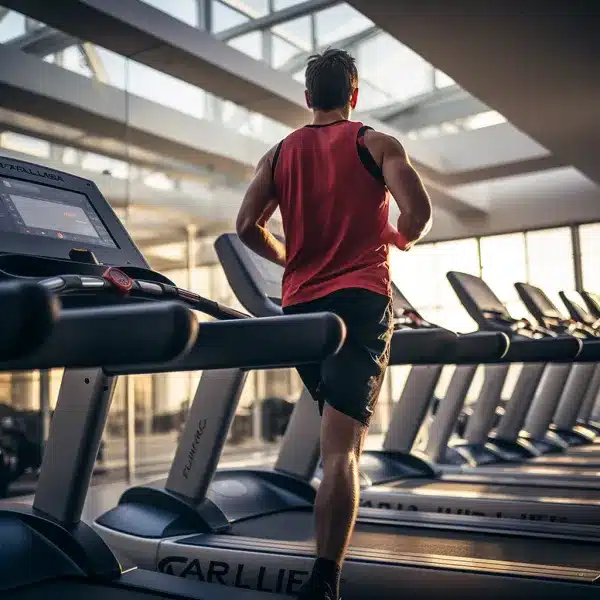Introduction
How Accurate Are Treadmill Calorie Counters: Treadmills are a ubiquitous sight in gyms and homes around the world. These exercise machines have become indispensable for fitness enthusiasts looking to shed pounds and improve their cardiovascular health. A prominent feature of modern treadmills is the built-in calorie counter, which claims to accurately track the number of calories burned during a workout. Many rely on these calorie counters to help them meet their weight loss goals and monitor their progress. However, the pressing question remains.
In we will delve into the science and technology behind these counters and evaluate their precision in measuring calorie expenditure. We’ll explore the factors that influence their accuracy, such as speed, incline, and individual variability. The differences between treadmill calorie counters and other methods of estimating calorie expenditure, like heart rate monitors and wearable fitness trackers. This exploration will provide valuable insights into the reliability of treadmill calorie counters and offer to individuals seeking accuracy about their workouts.
As we through this analysis, it’s crucial to understand the implications of the accuracy, or lack thereof, of treadmill calorie counters. This can help individuals make informed decisions about their fitness routines and better manage their dietary habits. So, let’s step onto the treadmill, figuratively speaking, and unravel the truth about how accurate these calorie counters truly are.


Are treadmill readings accurate?
They’ll usually calculate calories using speed, incline, and distance. Alyssa Lombardi, exercise physiologist, running coach, certified personal trainer, and CEO of Alyssa_RunFit Coaching, says treadmill calorie calculations are generally unreliable.
The quality, age, and maintenance of a treadmill affect its readings. Modern treadmills often provide accurate speed, distance, and time information. However, calorie burn and heart rate can be off.
Treadmill calorie burn estimations depend on weight, age, gender, pace, and inclination. These estimations are useful for tracking development but not always correct. Due to metabolic and running efficiency differences, they may overestimate or underestimate calorie burn.
Wearing a heart rate monitor during treadmill workouts improves accuracy. Heart rate can better evaluate effort and energy. To get more accurate data, calibrate your treadmill occasionally by comparing its readings to fitness trackers.
While treadmill readings can approximate your workout metrics, they may not be 100% accurate, especially calorie burn. Consider using extra monitoring instruments and treadmill calibration to acquire the most accurate information.
How many calories do you burn 30 minutes on treadmill?
Harvard Health found that a 155-pound person burns 335 calories in 30 minutes on an elliptical. For contrast, a 155-pound person running 10 minutes per mile on a treadmill for 30 minutes burns 372 calories.
Weight, intensity, and fitness level affect how many calories you burn in 30 minutes on a treadmill. A 30-minute treadmill workout burns 150–400 calories on average.
Weight greatly affects calorie burn. Weightier people burn more calories since they need more energy to exercise. A 30-minute brisk walk on a treadmill burns 223 calories for a 155-pound individual and 266 for a 185-pound person.
Workout intensity counts too. Running or jogging faster or on an uphill burns more calories than moderate walking. HIIT on the treadmill burns more calories due to short bursts of intense work.
Use heart rate monitors or fitness apps that account for weight and activity intensity to measure calorie burn more accurately. These estimates are approximations; individual variation may exist. Treadmill workouts can burn 150 to 400 calories in 30 minutes, depending on weight and intensity.
How many calories do you burn on a treadmill?
Running 20 minutes at 10kph burns 229 calories, while treadmill running at 12kph burns 299 calories. As discussed above, home treadmills provide more benefits than just burning calories.
People burn different amounts of calories on treadmills depending on numerous factors. Weight, age, gender, workout intensity, and treadmill session time are some of these characteristics. Moderate-intensity treadmill exercise burns 100–300 calories per 30 minutes.
The MET (Metabolic Equivalent of Task) system, which measures energy expenditure, is often used to estimate treadmill calories. Treadmill walking or running typically requires 3–9 METs, depending on speed and incline.
It’s important to remember that treadmill calorie counters may be inaccurate and measure calories burned differently. These estimates might still help you track your progress and create fitness objectives. Increase your workout intensity or duration to burn more calories. Please note that this is an estimate and individual variances can be large.
How accurate is the fitness calorie counter?
Smartwatches and fitness trackers can underestimate calorie burn during activity by 40% to 80%, according to various studies.
Treadmill and wearable fitness tracker calorie counters vary in accuracy. Despite improving over time, these gadgets are not always precise. The device’s sensors, calorie calculation algorithms, and metabolic rate variations can affect their precision.
Many treadmills have calorie counters that estimate calorie burn depending on weight, speed, and workout time. These estimations may not account for your specific physiology or other factors that affect calorie burn, such as heart rate or workout intensity.
However, wearable fitness trackers add heart rate data to motion sensors for more accurate assessments. Due to individual variances and heart rate measurement flaws, heart rate monitoring devices may not be perfect for estimating energy expenditure.
Fitness calorie counters can track workouts and progress, but they are approximate estimations of calorie burn. Talk to a trainer or use indirect calorimetry for the most accurate results.
Can I trust calories burned on treadmill?
Calories Burned On the Treadmill
Good news for treadmill fans: Experts say the calorie counter is accurate if you input your weight and don’t use the handrails. Olson complains that many treadmills don’t inquire about weight and use 155 lbs.
Caution is advised when trusting treadmill calorie calculations. Predetermined calculations estimate calories burned on treadmills based on weight, pace, and training time. These estimations can approximate your energy use, but they may be inaccurate.
Several factors affect estimation accuracy. Different metabolisms, workout intensities, and body types affect calorie burn. You may burn more calories than shown if you hold onto the handrails or use the treadmill’s incline option. Treadmill calorie counters don’t account for heart rate changes, which can greatly affect calorie expenditure.
You can use a heart rate monitor to measure calories more accurately. Fitness trackers and smartwatches with heart rate tracking can detect calorie burn more accurately. A treadmill with more advanced capabilities may estimate calorie expenditure more accurately.
However, treadmill calorie counters should be used as rough estimations rather than accurate measurements to track your exercises and progress. A heart rate monitor or fitness professional can help you calculate calorie burn more accurately.
How do I get accurate calories burned on a treadmill?
Calorie Burn Estimates
Many treadmills have a calorie display. You can improve its accuracy by entering your weight (including your clothing and shoes). The more weight, the more calories burned. If the machine doesn’t ask for weight, the calorie data it displays will very likely be inaccurate.
Use a heart rate monitor: Incorporating a heart rate monitor into your treadmill workouts is one of the most effective ways to get more accurate calorie burn estimates. It provides real-time data on your heart rate, which is a reliable indicator of your energy expenditure. Many fitness trackers and smartwatches have built-in heart rate monitors.
Enter your details: Make sure to input your age, weight, and other relevant into the treadmill’s settings accurately. Some treadmills allow you to customize these settings, which can lead to more precise calorie calculations. The more you vary your treadmill workout, the closer you’ll get to an accurate calorie estimate. Change the speed and incline during your session, as this will better mimic real-life variations in your exercise routine.
Avoid holding onto the handrails:
Holding onto the handrails of the treadmill can reduce the number of calories you burn by supporting your body weight. For a more accurate calorie burn estimate, try to walk or run without holding onto the handrails. High-end treadmills may come equipped with more accurate sensors and algorithms for calorie estimation. If precise calorie tracking is crucial for your fitness goals, investing in a high-quality treadmill may be worth it.
Cross-reference with other sources: Use multiple sources of data to cross-reference your calorie burn estimates. For example, you can compare the treadmill’s calculation with the data from your heart rate monitor or a fitness app to get a more accurate picture. While these steps can help improve the accuracy of your calorie estimates, there will always be some level of variability and estimation involved. Calorie burn is highly individual, and no method is perfect. However, by using these tips, you can get closer to an accurate representation of your energy expenditure during treadmill workouts.
Will I lose weight if I burn 500 calories a day on the treadmill?
Yes. Any calories lost contribute to the loss of weight. However, you have to make sure that you don’t simply eat back the calories you’ve lost from running on the treadmill. If you eat the 500 calories back, you’ll not make much progress with your weight loss.
Losing weight is a complex process that depends on multiple factors, with calorie expenditure being one of them. If you consistently burn 500 calories a day on the treadmill and maintain a calorie deficit, you are likely to lose weight. Weight loss occurs when you burn more calories than you consume.
To calculate your potential weight loss, consider that one pound of body weight is roughly equivalent to 3,500 calories. If you consistently burn 500 calories a day through treadmill exercise, you would create a weekly calorie deficit of 3,500 calories (500 calories x 7 days), which should lead to approximately a one-pound weight loss per week, assuming your diet remains unchanged.
Other factors like your metabolism, genetics, and the composition of your diet (e.g., macronutrient balance) can also impact the rate of weight loss. For sustainable and healthy weight loss, to combine regular exercise, like treadmill workouts, with a balanced diet. Consulting with a healthcare professional or registered dietitian can help you create a personalized weight loss plan tailored to your individual needs and goals.
How to burn 500 calories a day on treadmill?
Running at a pace of 6 mi (9.7 km) per hour—or 10 minutes per 1 mi (1.6 km)—can burn 500 calories in roughly 45 minutes. To shorten this time down to 30 minutes, you’ll need to run at a pace of 8 mi (13 km) per hour. Running interval sprints can shorten the time even further, down to about 25 minutes.
Set the Incline: To increase the intensity of your treadmill workout, consider raising the incline. Walking or running on an incline engages more muscles, making your workout more effective for calorie burning. Start with a moderate incline, and as you get more comfortable, increase it gradually.
Vary Your Speed: To keep your body challenged and prevent boredom, vary your speed throughout your workout. Incorporate interval training by alternating between periods of high-intensity running or brisk walking and lower-intensity recovery phases. This approach can boost your calorie burn significantly.
Extend Your Workout Time: The amount of time you spend on the treadmill plays a critical role in calorie burning. To burn 500 calories, you might need to spend around 45-60 minutes on the treadmill. Make sure to maintain a consistent pace and avoid leaning on the handrails for support, as this reduces the effectiveness of your workout.
Monitor Your Heart Rate: Invest in a heart rate monitor or use the built-in sensors on the treadmill to ensure you’re in your target heart rate zone. This helps you gauge the intensity of your workout and maximize calorie burning. Generally, you should aim for a heart rate that’s around 70-85% of your maximum heart rate.


Conclusion
In the quest for fitness and weight management, the accuracy of treadmill calorie counters has been a subject of great interest and debate. Our exploration into this matter reveals that these built-in counters, while a convenient tool for estimating calorie expenditure during a workout, come with limitations that affect their precision. Factors such as speed, incline, and individual differences in metabolic rate play a significant role in the accuracy of treadmill calorie counters. While they can provide a reasonable estimate of calories burned, they may not always be entirely reliable.
Despite their limitations, treadmill calorie counters can still be a valuable aid for tracking fitness progress and setting goals. However, it’s advisable to complement their data with other methods like heart rate monitors or wearable fitness trackers to get a more comprehensive view of one’s exercise intensity and calorie expenditure. This is particularly for individuals who rely on these counters for precise calorie tracking in their weight loss journey.
The accuracy of treadmill calorie counters varies, and while they can be a helpful tool, they should be used in conjunction with other monitoring methods for a more accurate assessment of calorie burn. It’s essential to remain informed about these limitations and make well-informed decisions about fitness and diet based on a more comprehensive view of one’s overall health and wellness.

